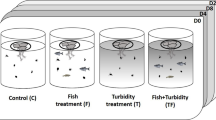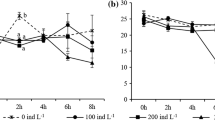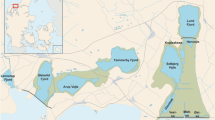Abstract
Employingin situ enclosures containing inocula of the lake zooplankton (mainlyDaphnia galeata, Daphnia cucullata andBosmina spp.) from a moderately eutrophic Lake Ros (Northern Poland) or large-bodiedDaphina magna, the following observations on succession of phytoplankton were made: 1) whereasD. magna could control the density of all the photoplankton size classes, the lake zooplankton could not suppress the large-sized phytoplankters or net phytoplankton; 2) the lake zooplankton was able to control the density of small algae (< 50µm), but its effect on large algae may be opposite: a promotion of net phytoplankton growth by removing small-sized algae which can out-compete net phytoplankton for limited PO4-P resources (<5µg P l−1).
Since efficiency of phytoplankton density control byD. magna decreased with an increase in net phytoplankton abundance, biomanipulation could not be successful without introducing or maintaining a high population of large-bodied cladoceran species before high densities of large algae would make the control of phytoplankton inefficient.
Similar content being viewed by others
References
Benndorf, J., H. Kneschke, K. Kossatz & E. Penz, 1984. Manipulation of the pelagic food web by stocking with predacious fishes. Int. Revue ges. Hydrobiol. 69: 407–428.
Carpenter, S., J. F. Kitchell & F. R. Hodgson, 1985. Cascading trophic interactions and lake productivity. Bioscience 35: 634–639.
Dawidowicz, P., 1989. Conditions which must be fullfilled to allow effective control of phytoplankton by zooplankton. Ph.D. Thesis, University of Warsaw, Warszawa, 48 pp.
Dawidowicz, P. & Z. M. Gliwicz, 1987. Biomanipulation. II. The role of direct and indirect relationship between photoplankton and zooplankton. Wiad. ekol. 33: 259–277 (in Polish, English summary).
Dawidowicz, P., Z. M. Gliwicz & R. D. Gulati, 1988. CanDaphnia prevent a blue-green algal bloom in hypertrophic lakes? A laboratory test. Limnologica (Berlin) 19: 21–26.
Downing, J. A. & F. H. Rigler, 1984. A manual on methods for the assesment of secondary productivity in fresh waters. IBP Handbook 17, Blackwell Scientific Publications, Oxford, 501 pp.
Geller, W. & H. Müller, 1981. The filtration apparatus of Cladocera: Filter mesh-sizes and their implications on food selectivity. Oecologia (Berl.) 49: 316–321.
Gliwicz, Z. M., 1977. Food size selection and seasonal succession of filter feeding zooplankton in an eutrophic lake. Ekol. pol. 25: 179–225.
Gliwicz, Z. M. & E. Siedlar, 1980. Food size limitation and algae interfering with food collection inDahpnia. Arch. Hydrobiol. 88: 155–177.
Golterman, H. L. & R. S. Clymo, 1969. Methods for chemical analysis for fresh waters. IBP Handbook 8, Blackwell Scientific Publications, Oxford, 172 pp.
Haney, J. F., 1987. Field studies on zooplankton-cyanobacteria interactions. N. Zeal. J. Mar. Freshwat. Res. 21: 467–475.
Hargrave, B. T. & G. H. Geen, 1968. Phosphorus excretion by zooplankton. Limnol. Ocreanogr. 13: 332–342.
Lampert, W., 1988. The relationship between zooplankton biomass and grazing: A review. Limnologica (Berlin) 19: 11–20.
Lehman, J. T., 1980a. Nutrient recycling as an interface between algae and grazers in freshwater communities. In W. C. Kerfoot (ed.), Evolution and Ecology of Zooplankton Communities. The University Press of New England, Hanover (N.H.); Lond.: 151–157.
Reynolds, C. S., 1984. The ecology of freshwater phytoplankton. Cambridge University Press, Cambridge, London, New York, New Rochelle, Melbourne, Sydney, 384 pp.
Shapiro, J., 1980. The importance of trophic-level interactions to the abundance and species composition of algae in lakes. Dev. Hydrobiol. 2: 105–116.
Shapiro, J. & D. I. Wright, 1984. Lake restoration by biomanipulation: Round Lake, Minnesota, the first two years. Freshwat. Biol. 14: 371–383.
Shapiro, J., V. Lammara & M. Lynch, 1975. Biomanipulation: An ecosystem approach to lake restoration. In P. L. Brezonik & J. L. Fox (eds), Proc. Symp. Water quality management through biological control. Rep. No. ENV-07-75-1, University of Florida, Gainsville: 85–96.
Webster, K. E. & R. H. Peters, 1977. Some size-dependent inhibition of larger cladoceran filterers in filamentous suspension. Limnol. Oceanogr. 23: 1238–1245.
Author information
Authors and Affiliations
Rights and permissions
About this article
Cite this article
Dawidowicz, P. Effectiveness of phytoplankton control by large-bodied and small-bodied zooplankton. Hydrobiologia 200, 43–47 (1990). https://doi.org/10.1007/BF02530327
Issue Date:
DOI: https://doi.org/10.1007/BF02530327




